#Chandra
Explore tagged Tumblr posts
Text
25 Years of Exploring the Universe with NASA's Chandra Xray Observatory
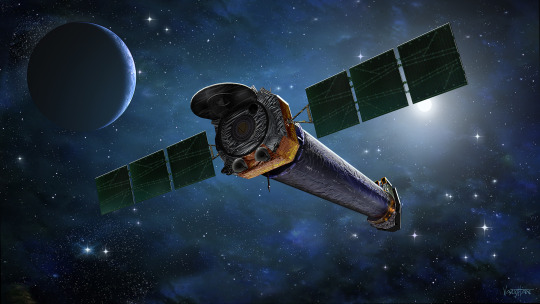
Illustration of the Chandra telescope in orbit around Earth. Credit: NASA/CXC & J. Vaughan
On July 23, 1999, the space shuttle Columbia launched into orbit carrying NASA’s Chandra X-ray Observatory. August 26 marked 25 years since Chandra released its first images.
These were the first of more than 25,000 observations Chandra has taken. This year, as NASA celebrates the 25th anniversary of this telescope and the incredible data it has provided, we’re taking a peek at some of its most memorable moments.
About the Spacecraft
The Chandra telescope system uses four specialized mirrors to observe X-ray emissions across the universe. X-rays that strike a “regular��� mirror head on will be absorbed, so Chandra’s mirrors are shaped like barrels and precisely constructed. The rest of the spacecraft system provides the support structure and environment necessary for the telescope and the science instruments to work as an observatory. To provide motion to the observatory, Chandra has two different sets of thrusters. To control the temperatures of critical components, Chandra's thermal control system consists of a cooling radiator, insulators, heaters, and thermostats. Chandra's electrical power comes from its solar arrays.
Learn more about the spacecraft's components that were developed and tested at NASA’s Marshall Space Flight Center in Huntsville, Alabama. Fun fact: If the state of Colorado were as smooth as the surface of the Chandra X-ray Observatory mirrors, Pike's Peak would be less than an inch tall.

Engineers in the X-ray Calibration Facility at NASA’s Marshall Space Flight Center in Huntsville, Alabama, integrating the Chandra X-ray Observatory’s High-Resolution Camera with the mirror assembly, in this photo taken March 16, 1997. Credit: NASA
Launch
When space shuttle Columbia launched on July 23, 1999, Chandra was the heaviest and largest payload ever launched by the shuttle. Under the command of Col. Eileen Collins, Columbia lifted off the launch pad at NASA’s Kennedy Space Center in Florida. Chandra was deployed on the mission’s first day.
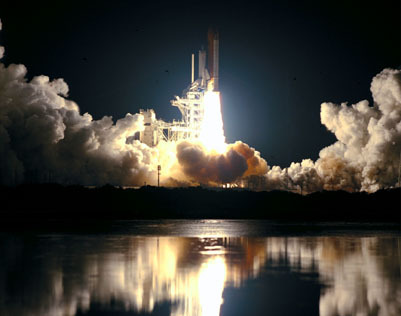
Reflected in the waters, space shuttle Columbia rockets into the night sky from Launch Pad 39-B on mission STS-93 from Kennedy Space Center. Credit: NASA
First Light Images
Just 34 days after launch, extraordinary first images from our Chandra X-ray Observatory were released. The image of supernova remnant Cassiopeia A traces the aftermath of a gigantic stellar explosion in such captivating detail that scientists can see evidence of what is likely the neutron star.
“We see the collision of the debris from the exploded star with the matter around it, we see shock waves rushing into interstellar space at millions of miles per hour,” said Harvey Tananbaum, founding Director of the Chandra X-ray Center at the Smithsonian Astrophysical Observatory.

Cassiopeia A is the remnant of a star that exploded about 300 years ago. The X-ray image shows an expanding shell of hot gas produced by the explosion colored in bright orange and yellows. Credit: NASA/CXC/SAO
A New Look at the Universe
NASA released 25 never-before-seen views to celebrate the telescopes 25th anniversary. This collection contains different types of objects in space and includes a new look at Cassiopeia A. Here the supernova remnant is seen with a quarter-century worth of Chandra observations (blue) plus recent views from NASA’s James Webb Space Telescope (grey and gold).
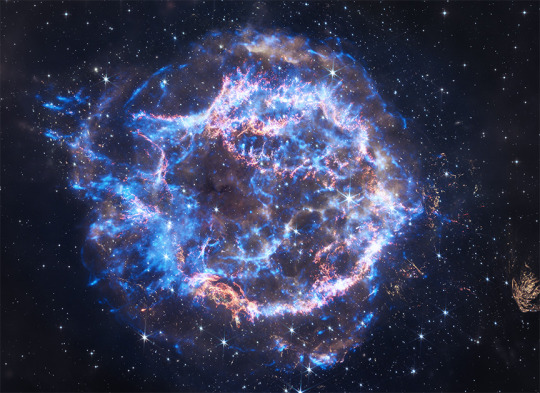
This image features deep data of the Cassiopeia A supernova, an expanding ball of matter and energy ejected from an exploding star in blues, greys and golds. The Cassiopeia A supernova remnant has been observed for over 2 million seconds since the start of Chandra’s mission in 1999 and has also recently been viewed by the James Webb Space Telescope. Credit: NASA/CXC/SAO
Can You Hear Me Now?
In 2020, experts at the Chandra X-ray Center/Smithsonian Astrophysical Observatory (SAO) and SYSTEM Sounds began the first ongoing, sustained effort at NASA to “sonify” (turn into sound) astronomical data. Data from NASA observatories such as Chandra, the Hubble Space Telescope, and the James Webb Space Telescope, has been translated into frequencies that can be heard by the human ear.
SAO Research shows that sonifications help many types of learners – especially those who are low-vision or blind -- engage with and enjoy astronomical data more.
Click to watch the “Listen to the Universe” documentary on NASA+ that explores our sonification work: Listen to the Universe | NASA+
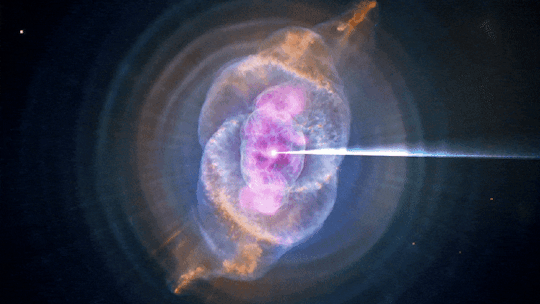
An image of the striking croissant-shaped planetary nebula called the Cat’s Eye, with data from the Chandra X-ray Observatory and Hubble Space Telescope. NASA’s Data sonification from Chandra, Hubble and/or Webb telecopes allows us to hear data of cosmic objects. Credit: NASA/CXO/SAO
Celebrate With Us!
Dedicated teams of engineers, designers, test technicians, and analysts at Marshall Space Flight Center in Huntsville, Alabama, are celebrating with partners at the Chandra X-ray Center and elsewhere outside and across the agency for the 25th anniversary of the Chandra X-ray Observatory. Their hard work keeps the spacecraft flying, enabling Chandra’s ongoing studies of black holes, supernovae, dark matter, and more.
Chandra will continue its mission to deepen our understanding of the origin and evolution of the cosmos, helping all of us explore the Universe.

The Chandra Xray Observatory, the longest cargo ever carried to space aboard the space shuttle, is shown in Columbia’s payload bay. This photo of the payload bay with its doors open was taken just before Chandra was tilted upward for release and deployed on July 23, 1999. Credit: NASA
Make sure to follow us on Tumblr for your regular dose of space: http://nasa.tumblr.com
2K notes
·
View notes
Text








Images to Celebrate NASA’s Chandra 25th Anniversary
These images, which all include data from Chandra, demonstrate how X-ray astronomy explores all corners of the universe. By combining X-rays from Chandra with other space-based observatories and telescopes on the ground, as many of these images do, astronomers can tackle the biggest questions and investigate long-standing mysteries across the cosmos.
On July 23, 1999, the space shuttle Columbia launched into orbit carrying Chandra, which was then the heaviest payload ever carried by the shuttle. With Commander Eileen Collins at the helm, the astronauts aboard Columbia successfully deployed Chandra into its highly elliptical orbit that takes it nearly one-third of the distance to the Moon.
X-rays are an especially penetrating type of light that reveals extremely hot objects and very energetic physical processes. Many fascinating regions in space glow strongly in X-rays, such as the debris from exploded stars and material swirling around black holes. Stars, galaxies, and even planets also give off X-rays that can be studied with Chandra.
NASA/SAO/CXC
2K notes
·
View notes
Text










got obsessed with the space telescopes for a lil while hehehe. revamped my designs for jwst and hst and tried my hand at designing some of the other "great observatories" as well! i like to think hubble, spitzer, and chandra are all siblings (and james is just kinda crashing the party here).
some extra thoughts under the readmore
so theres four great observatories, but the fourth, compton, was purposefully de-orbited and burnt up in the atmosphere. haven't designed her yet, but her death haunts the other space telescopes a lot hehe.
hubble was the first of the siblings to be launched, with compton launching shortly afterwards. they were pretty close before her eventual demise. unfortunately her death and chandra's launch sort of overlapped, so hubble and chandra's initial relationship was heavily strained by the grief hubble was feeling.
theyre doing alright nowadays, but its still kind of a sore subject. this is especially true because hubble fears he may share the same fate in a couple years. with the lack of funding and his failing systems, it's very likely he may be de-orbited as well.
#art#my art#artists on tumblr#astronomy#space telescopes#hst#jwst#spitzer#chandra#hubble space telescope#james webb space telescope#spitzer space telescope#chandra x ray observatory#space personification
215 notes
·
View notes
Text

I hope this is what Chandra wears when she marries Nissa
386 notes
·
View notes
Text


probably a title card i think...
#magical girl#magical girls#mahou shoujo#magical warrior diamond heart#mwdh#full color#original: mwdh#original art#chandra
243 notes
·
View notes
Text
planetary influence on one's appearance [some keywords]
MARS | mangal | मंगल देव
- strong: cheekbones, nose bridge, gaze
- fleshy: round cheeck apples, full foreheads, fleshy chin, rounded under-eye area
- attractive: sexy, warm, seductive
MOON | chandra | चंद्र माँ
- inviting: alluring, dazzling, beautiful
- Lush: soft, full, plentiful
- emotive eyes: childlike, expressive
VENUS | shukra | शुक्र देव
- milky: watery, wet, cool
- artful: fashionable, skillful, artistic, heavenly
- hair styles preferred: long black hair, shags, messy mullet like styles, historical hair styles, intricate designs (braids, ribbons, etc)

#venus#moon#mars#shukra#mangal#chandra#shukra dev shares a lineage with lord Krishna#🥛#fran fine has ketu in bharani
144 notes
·
View notes
Text

Any MTG fans on here? 🔥 Here’s a Chandra Chibi sticker to add to your collection! ❤️
#artists on tumblr#chibi#fanart#art#stickers#digital art#procreate#Chandra#chandra nalaar#mtgcommunity#mtg art#mtg#mtg commander#magic the gathering
209 notes
·
View notes
Text



#moon#chandra#mercury#chandra's son#vedic astrology#nakshatras#lunar energy#satvik#moon nakshatra#lua#rohini#shravana#hasta#hasta nakshatra#rohini nakshatra#shravana nakshatra#subconscious#dual#virgo#taurus#capricorn#symbiotic#venus#shukra#fashionastro#subconscious mind#jyotish#atmakaraka#lagnesha#vedic astrology observations
73 notes
·
View notes
Text



Some more Magic: The Gathering goodies!
Some standalone Packaging character assets for the Aetherdrift set.
Chandra - Play Booster Saheeli - Commander Deck Temmet - Commander Deck (Colour varies from marketing final)
AD : Anthony Garzzona
#magic the gathering#aetherdrift#chandra#temmet#saheeli#packaging art#mtg commander#mtg art#i should probably post more magic stuff really
86 notes
·
View notes
Text
The Rashi Names In Vedic Astrology

RASHI = Sign
ARIES = Meesha
TAURUS = Vrishabha
GEMINI = Mithuna
CANCER = Karka
LEO = Simha
VIRGO = Kanya
LIBRA = Tula
SCORPIO = Vrischika
SAGITTARIUS = Dhanu
CAPRICORN = Makara
AQUARIUS = Kumbha
PISCES = Meena

PLANETARY NAME TRANSLATIONS
SUN = Surya
MOON = Chandra
MERCURY = Budha
VENUS = Sukra
MARS = Mangal
JUPITER = Guru
SATURN = Shani
NORTH NODE = Rahu
SOUTH NODE = Ketu
120 notes
·
View notes
Text

For 30 Doradus to look like this, it needs data in X-ray, visible, infrared, and radio wavelengths. Data from the Hubble Space Telescope was paired up with data from the Chandra X-Ray Observatory, Spitzer Space Telescope, and the Atacama Large Millimeter/submillimeter Array to produce this composite image.
The massive young stars in 30 Doradus send out strong winds into space. Along with the matter and energy ejected by stars that have previously exploded, these winds have carved out arcs, pillars, and bubbles.
A dense cluster in the center of the nebula contains the most massive stars astronomers have ever found, each only about one to 2 million years old. (Our sun, for comparison, is about 5 billion years old.)
Credit: X-ray: NASA/CXC/Penn State Univ./L. Townsley et al.; Infrared: NASA/JPL-CalTech/SST; Optical: NASA/STScI/HST; Radio: ESO/NAOJ/NRAO/ALMA; Image Processing: NASA/CXC/SAO/J. Schmidt, N. Wolk, K. Arcand.
#space#astronomy#stsci#science#nasa#universe#esa#chandra#chandra x ray observatory#spitzer#hubble#hubble space telescope#30 doradus#ALMA
61 notes
·
View notes
Text
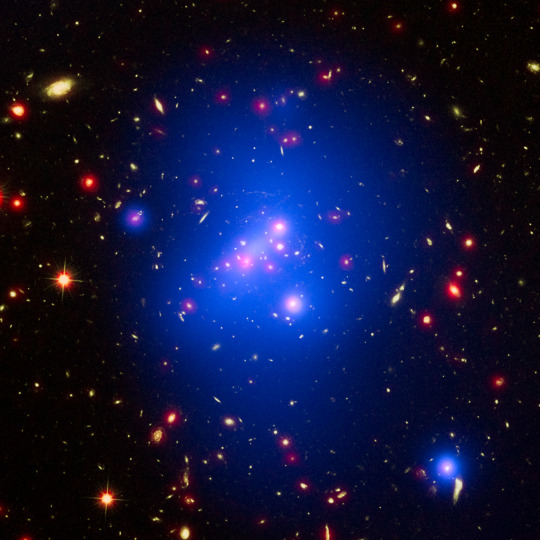
Astronomers used three of NASA's Great Observatories to capture this multiwavelength image showing galaxy cluster IDCS J1426.5+3508. It includes X-rays recorded by the Chandra X-ray Observatory in blue, visible light observed by the Hubble Space Telescope in green, and infrared light from the Spitzer Space Telescope in red. This rare galaxy cluster has important implications for understanding how these megastructures formed and evolved early in the universe.
How Astronomers Time Travel
Let’s add another item to your travel bucket list: the early universe! You don’t need the type of time machine you see in sci-fi movies, and you don’t have to worry about getting trapped in the past. You don’t even need to leave the comfort of your home! All you need is a powerful space-based telescope.
But let’s start small and work our way up to the farthest reaches of space. We’ll explain how it all works along the way.
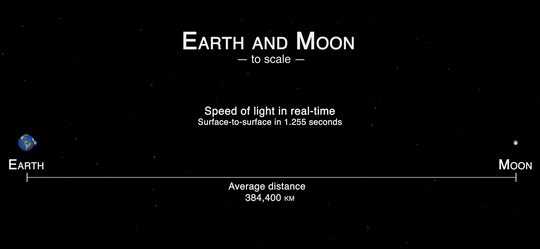
This animation illustrates how fast light travels between Earth and the Moon. The farther light has to travel, the more noticeable its speed limit becomes.
The speed of light is superfast, but it isn’t infinite. It travels at about 186,000 miles (300 million meters) per second. That means that it takes time for the light from any object to reach our eyes. The farther it is, the more time it takes.
You can see nearby things basically in real time because the light travel time isn’t long enough to make a difference. Even if an object is 100 miles (161 kilometers) away, it takes just 0.0005 seconds for light to travel that far. But on astronomical scales, the effects become noticeable.
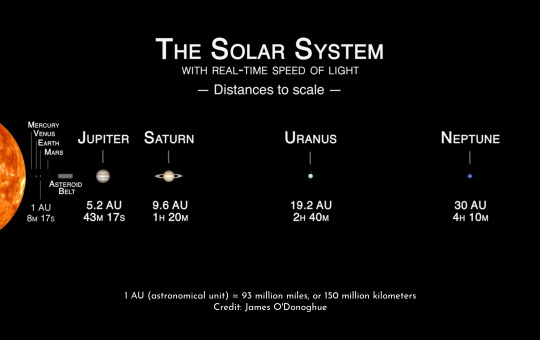
This infographic shows how long it takes light to travel to different planets in our solar system.
Within our solar system, light’s speed limit means it can take a while to communicate back and forth between spacecraft and ground stations on Earth. We see the Moon, Sun, and planets as they were slightly in the past, but it's not usually far enough back to be scientifically interesting.
As we peer farther out into our galaxy, we use light-years to talk about distances. Smaller units like miles or kilometers would be too overwhelming and we’d lose a sense of their meaning. One light-year – the distance light travels in a year – is nearly 6 trillion miles (9.5 trillion kilometers). And that’s just a tiny baby step into the cosmos.
youtube
The Sun’s closest neighboring star, Proxima Centauri, is 4.2 light-years away. That means we see it as it was about four years ago. Betelgeuse, a more distant (and more volatile) stellar neighbor, is around 700 light-years away. Because of light’s lag time, astronomers don’t know for sure whether this supergiant star is still there! It may have already blasted itself apart in a supernova explosion – but it probably has another 10,000 years or more to go.
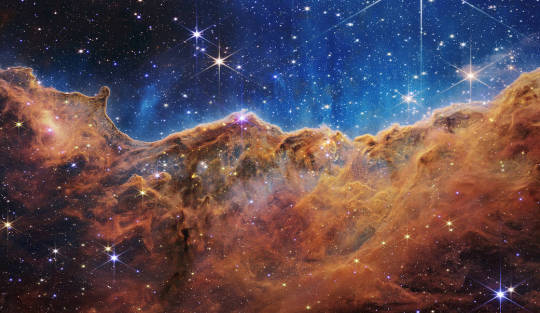
What looks much like craggy mountains on a moonlit evening is actually the edge of a nearby, young, star-forming region NGC 3324 in the Carina Nebula. Captured in infrared light by the Near-Infrared Camera (NIRCam) on NASA’s James Webb Space Telescope, this image reveals previously obscured areas of star birth.
The Carina Nebula clocks in at 7,500 light-years away, which means the light we receive from it today began its journey about 3,000 years before the pyramids of Giza in Egypt were built! Many new stars there have undoubtedly been born by now, but their light may not reach Earth for thousands of years.
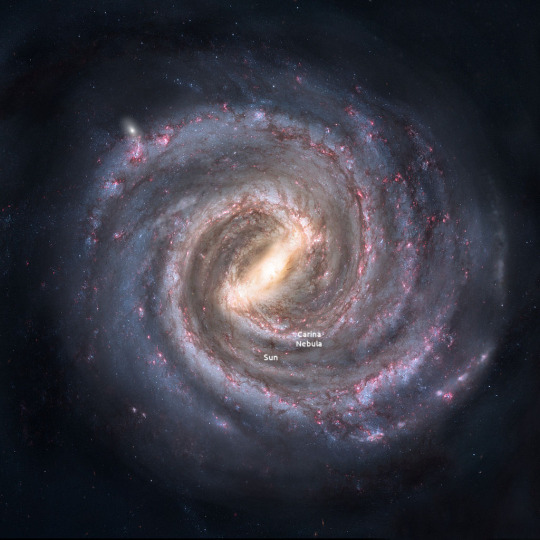
An artist’s concept of our Milky Way galaxy, with rough locations for the Sun and Carina nebula marked.
If we zoom way out, you can see that 7,500 light-years away is still pretty much within our neighborhood. Let’s look further back in time…
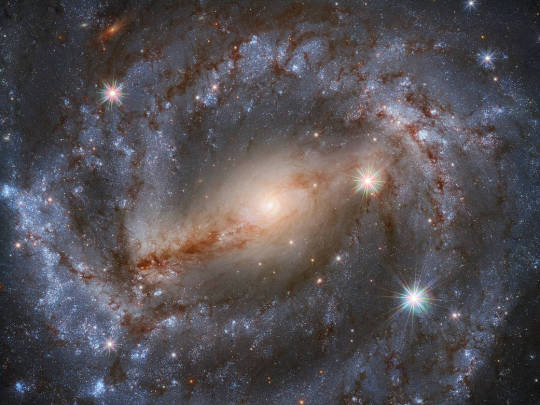
This stunning image by the NASA/ESA Hubble Space Telescope features the spiral galaxy NGC 5643. Looking this good isn’t easy; 30 different exposures, for a total of nine hours of observation time, together with Hubble’s high resolution and clarity, were needed to produce an image of such exquisite detail and beauty.
Peering outside our Milky Way galaxy transports us much further into the past. The Andromeda galaxy, our nearest large galactic neighbor, is about 2.5 million light-years away. And that’s still pretty close, as far as the universe goes. The image above shows the spiral galaxy NGC 5643, which is about 60 million light-years away! That means we see it as it was about 60 million years ago.
As telescopes look deeper into the universe, they capture snapshots in time from different cosmic eras. Astronomers can stitch those snapshots together to unravel things like galaxy evolution. The closest ones are more mature; we see them nearly as they truly are in the present day because their light doesn’t have to travel as far to reach us. We can’t rewind those galaxies (or our own), but we can get clues about how they likely developed. Looking at galaxies that are farther and farther away means seeing these star cities in ever earlier stages of development.
youtube
The farthest galaxies we can see are both old and young. They’re billions of years old now, and the light we receive from them is ancient since it took so long to traverse the cosmos. But since their light was emitted when the galaxies were young, it gives us a view of their infancy.

This animation is an artist’s concept of the big bang, with representations of the early universe and its expansion.
Comparing how fast objects at different distances are moving away opened up the biggest mystery in modern astronomy: cosmic acceleration. The universe was already expanding as a result of the big bang, but astronomers expected it to slow down over time. Instead, it’s speeding up!
The universe’s expansion makes it tricky to talk about the distances of the farthest objects. We often use lookback time, which is the amount of time it took for an object’s light to reach us. That’s simpler than using a literal distance, because an object that was 10 billion light-years away when it emitted the light we received from it would actually be more than 16 billion light-years away right now, due to the expansion of space. We can even see objects that are presently over 30 billion light-years from Earth, even though the universe is only about 14 billion years old.

This James Webb Space Telescope image shines with the light from galaxies that are more than 13.4 billion years old, dating back to less than 400 million years after the big bang.
Our James Webb Space Telescope has helped us time travel back more than 13.4 billion years, to when the universe was less than 400 million years old. When our Nancy Grace Roman Space Telescope launches in a few years, astronomers will pair its vast view of space with Webb’s zooming capabilities to study the early universe in better ways than ever before. And don’t worry – these telescopes will make plenty of pit stops along the way at other exciting cosmic destinations across space and time.
Learn more about the exciting science Roman will investigate on X and Facebook.
Make sure to follow us on Tumblr for your regular dose of space!
#NASA#astronomy#telescope#Roman Space Telescope#dark energy#galaxies#cosmology#astrophysics#stars#galaxy#Hubble#Webb#Chandra#Spitzer#space images#Youtube
3K notes
·
View notes
Text
They kinda forgot to wrap up Chandra's emotional arc in Aetherdrift, so have some flash fiction
Chandra had put up a valiant effort to remain composed for the Ghirapur Grand Prix victory ceremony, but as soon as she was able to politely excuse herself, she collapsed into Nissa's arms. She spent the ride home with her head in the elf's lap, barely holding in sobs of pain. A small, spiteful part of Nissa wanted to kill Jace for hurting the woman she loved like this. But vengeance wasn't what her girlfriend needed right now. While Chandra tried to play it off as a severe migraine, her soft cries let out hints to the truth. Whatever psychic attack Jace had unleashed to scramble her senses had stirred up a storm of fears and anxieties, both new and old. Snippets of trauma Nissa hadn't even known about leaked out through tears and mingled with familiar wounds in what must have been a vicious storm of emotion. Cries for her father. For her mother. For Gideon. For Nissa. Especially for Nissa. She knew how much this race meant to Chandra. Gods, she knew. And she hated it. She hated to see her like this, her normally mercurial mind finally fixated on something long enough to worry herself sick over it. She intimately knew how badly Chandra wanted to do this for her, to help fix things for her, to make her happy. But it was only now that she realized how much this desperation was driven by fear. Fear of how upset Nissa must be, now that she failed. Fear of how Nissa would never give a genuine smile again. How she'd ruined Nissa's life with this failure. That she was a failure. That she didn't deserve Nissa, and that Nissa would have every right to leave her after this. So, so much self-loathing that had been dredged up from where it had been festering in the recesses of her mind. And that was only what she let slip out. There was no telling how much more there was being kept bottled up inside.
For the sake of her girlfriend's pride, she waited to say something until after Pia had finished helping her carry Chandra up to their bedroom. It gave her time to figure out the correct sequence of words to say. She wished she had Jace's powers so she could simply project her feelings directly into Chandra's head, but that was what gotten her into the state she was in in the first place. Finally, she settled on something simple. She sat on the bed and placed a hand on her girlfriend's back. "I love you, Chandra," she said.
Immediately, the tears that the hero of Avishkar had barely been holding at bay came pouring out. Half-coherent apologies tumbled out of her mouth, punctuated by body-wracking sobs. Nissa wasn't quite sure if Chandra even knew what she was apologizing for. She buried her face in Nissa's lap, and Nissa stroked her reassuringly.
"I need you to know that I'm not mad at you," she said as gently as she could. "I know you wanted the Aetherspark for me, but I need you to know I don't need it. Yes, I miss Zendikar dearly. Of course I do. But you've shown me that anywhere can be home as long as I'm with you. You don't need to be a big damn hero for me to love you. You don't need to be the hero of Avishkar, savior of the multiverse, slayer of Eldrazi. You just need to be here, with me."
The sobs intensified and Chandra clung tighter to her girlfriend.
"You just need to be Chandra, my girlfriend who I love very much. Even when she doesn't love herself."
57 notes
·
View notes
Text

leaf head!!
490 notes
·
View notes
Text
Meow-gic: The Gathering

#magic: the gathering#mtg#Chandra#red mana#burn deck#cat cosplay#cosplay#cats#kitty#cats in costumes#cat#cats of tumblr#aww#cat costume#fan art
398 notes
·
View notes
Text
Not Malini turning understatement into the greatest art form with this absolute banger of a line:
"Let me simply say, the men of my family have a problem with overindulgence in religion."
Like...ma'am. One of your brothers gave up an empire and the other spends his spare time burning women to death to purify them.
#the jasmine throne#the burning kingdoms#malini#chandra#aditya#books and reading#books#books and novels
37 notes
·
View notes